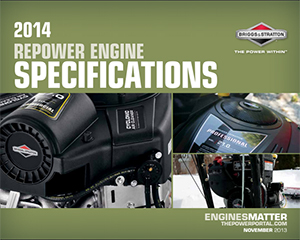How do I find Briggs & Stratton engine specifications?
When doing lawn mower engine repair and maintenance, you may need to find specific parts and specifications for your equipment.
You will need to know your small engine model specs if you’ve asked:
- What oil type does my engine need?
- What is the valve clearance for my small engine?
- What is the head bolt torque for my engine?
- What type of gas should I put in my lawn mower?
- What parts do I need for a horizontal or vertical shaft replacement?
To find basic small engine specs like torque, fuel & oil type, filter or cylinder info, check out specific product pages for your snow blower, lawn mower, Riding Mower or utility engines.
The complete source of specification information would be your engine's repair manual (Lookup Repair Manual by Model Number). Knowing your small engine model number also provides basic specifications such as valve settings, bore, stroke, etc.

For a general guide, our Replacement Engine Catalog PDF (Large file - 38 MB) contains all of our service replacement engines. The guide provides the measurements of the engines, specification information, and other valuable dimensions, numbers, etc.
PLEASE NOTE: The engines listed in this catalog are meant to fit a wide variety of equipment and may NOT necessarily be the exact engine you have currently on your equipment or the one that you are planning on purchasing.
If you wish to replace your current engine, ensure that your replacement engine will fit and perform properly with your existing application by consulting a local Briggs & Stratton Dealer.
How Engine Power Ratings Work
As you begin to understand how engine specifications work, its important to note that the gross power rating for individual gas engine models is labeled in accordance with SAE (Society of Automotive Engineers) code J1940 (Small Engine Power & Torque Rating Procedure), and rating performance has been obtained and corrected in accordance with SAE J1995 (Revision 2002-05).
- Torque values are derived at 2600 RPM
- Horsepower values are derived at 3600 RPM
- Actual gross engine power will be lower and will be affected by, among other things, ambient operating conditions and engine-to-engine variability
Given both the wide array of products on which engines are placed and the variety of environmental issues applicable to operating the equipment, the gas engine will not develop the rated gross power when used in a given piece of power equipment (actual "on-site" or net horsepower).
This difference is due to a variety of factors including, but not limited to, accessories (air cleaner, exhaust, charging, cooling, carburetor, fuel pump, etc.), application limitations, ambient operating conditions (temperature, humidity, altitude), and engine-to-engine variability.
Due to manufacturing and capacity limitations, Briggs & Stratton may substitute an engine of higher rated power for this Series engine.




